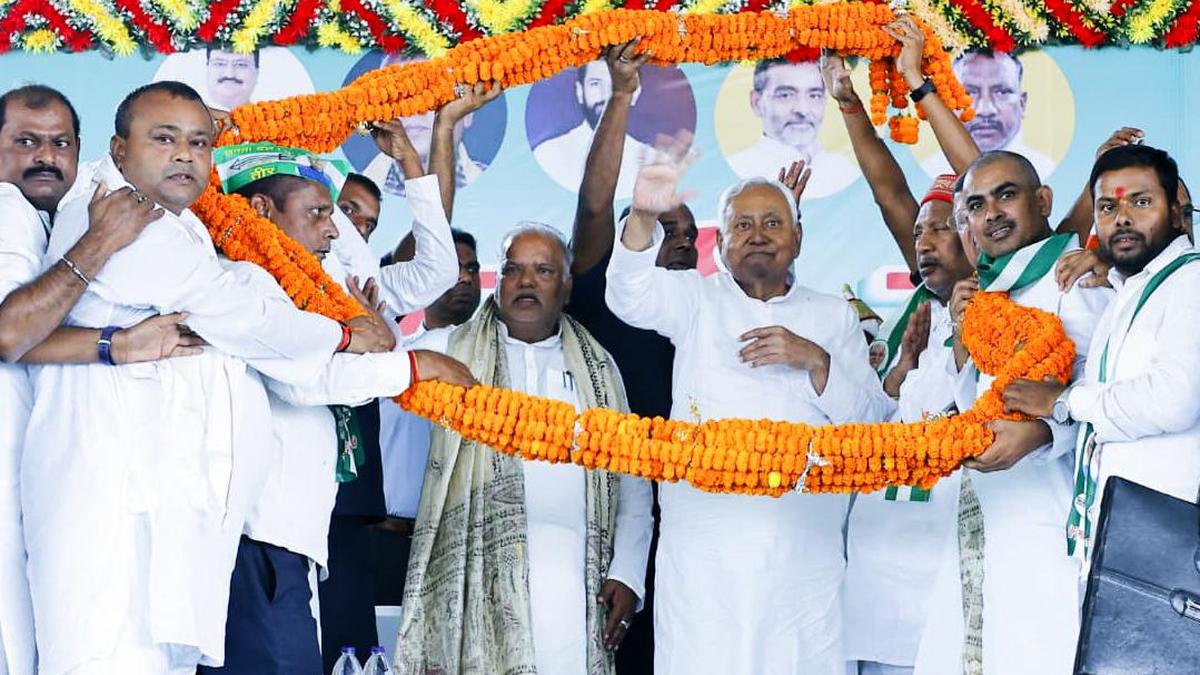Upnesh Kumar, 79, sums up three decades of Bihar politics in three sentences about electricity supply to his village.
“During Jaganath Mishra’s time (December 1989- March 1990) even before you could run the fields after switching on the motor the power would go. In Lalu’s era (March 1990-November 2005) all power lines were down. Under Nitish Kumar (November 2005 onwards) we get 22-23 hours of power each day,” Mr. Upnesh Kumar said. He is a kurmi, the same caste as Chief Minister Nitish Kumar.
At the end of two decades in power, Mr. Nitish Kumar remains the centrepiece of Bihar politics. But this election is more about the question: is it Mr. Nitish Kumar’s swansong or does he have another symphony left in him.
It has been a long journey for him. In 1977 at the crest of the anti-Congress wave many young socialist leaders briskly rode to Parliament, but Nitish lost the elections by 5,895 votes, sticking out as an odd one among his socialist colleagues. He did no better the second time around. In the 1980 Assembly polls, he was defeated again. It was only in his third outing in 1985 Assembly elections that he finally tasted victory. He was never again without a seat in a legislature. Since 1995, Harnaut has been with the Samata party and then the Janata Dal (United).
Bihar’s economic development has been chequered. Mr. Nitish Kumar is credited for his administrative acumen, yet there is statistical evidence often cited by his opponents to underline his failures.

In response to a question by JD(U) MP Giridhari Yadav in the last session, the Parliament was told that as per the provisional estimates released on May 30, 2025, the per capita Net National Income is ₹2,05,324, while that of Bihar is ₹69,321. Bihar’s share of national GDP also remains less than three per cent. In 1960-61 united Bihar was at 7.8 % — fourth highest in the country. On split, with Jharkhand being carved out, it came down to 2.8% in 2000-01 and has remained stagnant in the same figure in 2023-24 as per the Economic Advisory Council to the PM’s September 2024 report on “Relative Economic Performance of Indian States.”
These statistics cut little ice in Harnaut where the neat tree-lined roads, regular water and power supply, are seen as better markers for the elusive “vikas” (development) that politicians talk about but the voters rarely get to see.
Mr. Upnesh Kumar’s neighbour Ashutosh Kumar (65), also a kurmi, chimes in. “There is no one who is as trustworthy as him in any party, BJP included.” he said. The speculation about his declining mental acuity and BJP’s machinations to push him out of the Chief Minister’s chair, is earning him sympathy of the electorate here.
Two complaints
Nitish’s untainted persona is hailed; but there are two common complaints — the growing dominance of bureaucracy and the JD(U) legislators. JD(U) dropped only four of its sitting legislators.
Kalyan Bigha is Mr. Nitish Kumar’s ancestral village. Here his two-storey house stands next to the village pond. An unadorned structure, that bears no distinguishing marks of its owner. A padlock hangs from the brown wooden door. The windows are shuttered. The house stands aloof, much like its owner.
Pappu Thakur, who belongs to Nai community listed as Extremely Backward Community, has a shop opposite to the Chief Minister’s home. He is a men’s tailor. His eyes are trained on the fabric in hand, he measures, marks, and cuts it using a heavy iron scissor, without once pausing while simultaneously delivering an appraisal of the Nitish government. His vote remains for the JD(U), after all, if not for the infrastructure that Nitish government built, he argues, could he have returned, after living in Mumbai for 21 years. But he is not an uncomplaining voter. Nitish visits his home thrice in year to pay respect to his deceased parents and wife, each time he comes in a cordon of bureaucrats and police. A phantom, unseen and unheard by his own villagers, he laments. He is angry that the JD(U) didn’t change Harnaut’s MLA Harinarayan Singh, who has been in the seat since 2010.
The electorate could have done with a new face and younger candidate, he says. Harnaut has been a battleground of the JD(U) vs Lok Janshakti Party. For the last three elections it has been a direct contest between the two. For the first time, the two parties are on the same side, allowing the Congress which has fielded to take the space of challenger here.
In the Nalanda constituency, where Rural Development Minister and JD(U) leader Sharwan Kumar is in fray, voters cite similar complaints. At a tea shop, Lav Kumar Mishra, Chandrakant Prasad, a Kurmi, and P.K. Verma, a Chandravanshi, are sipping the evening cup of tea in tiny kulhads. Mr. Mishra, the most vocal of the three, begins the conversation. Chandravanshi falls in the Extremely Backward Category. “Sharwan Kumar wins only because he is contesting from the JD(U), otherwise he would not win a panchayat election,” he declares. The other two nod in agreement. Their complaint is that he is working through “agents” in villages, disconnected from the populace. While Mr. Mishra takes the next step declaring that he will vote for the Jan Suraj Party this time, simply because he is eager to see change, the other two don’t agree. “Prashant Kisor is untested. Nitish Kumar is tested and trusted,” Mr. Verma said.
In Nalanda for now it is Mr. Nitish Kumar.
Published – October 26, 2025 08:47 pm IST
